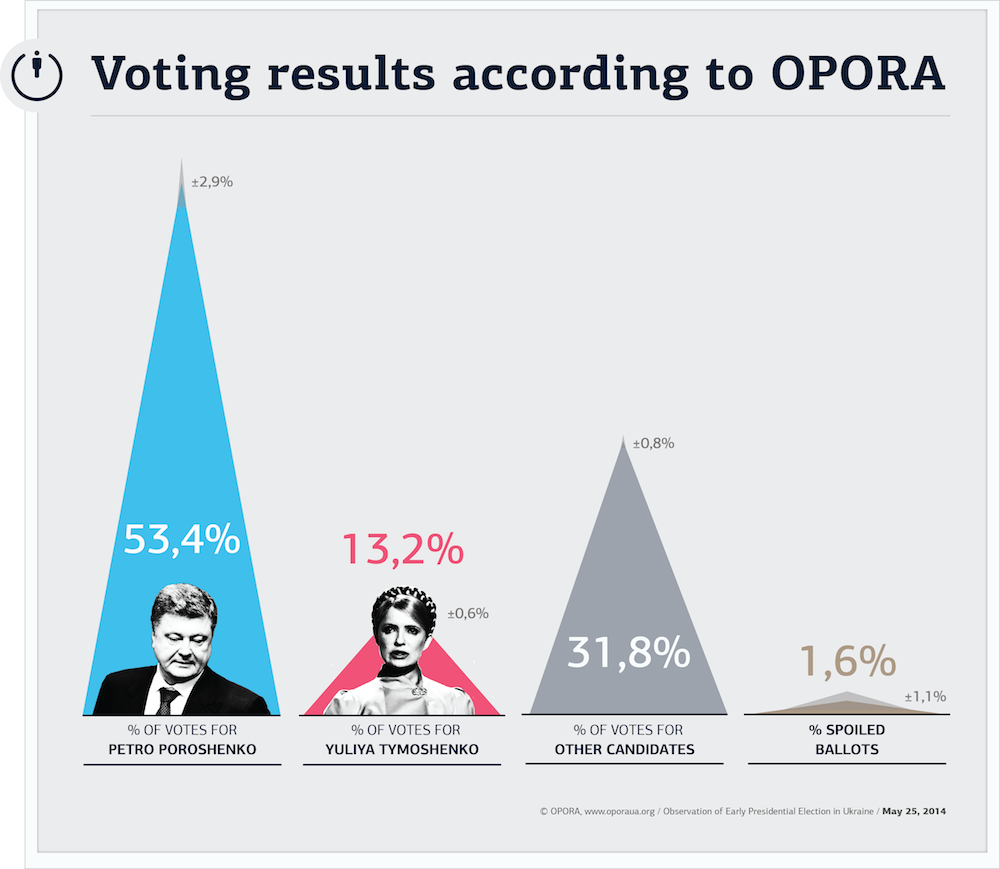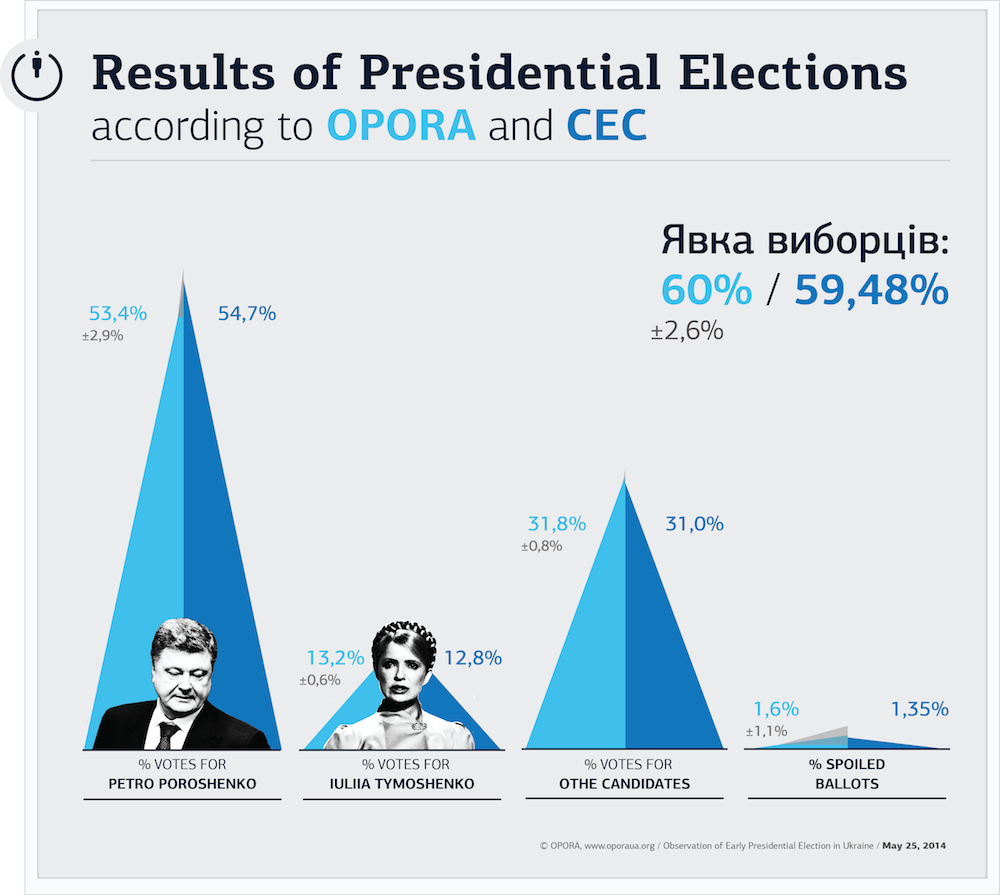25 May, Election of the President of Ukraine was conducted fairly and in accordance with Ukrainian legislation and international standards. Parliament and the CEC have duly secured the organization of electoral process and conduction of voting on the election day. The voting was held on the whole Ukrainian territory (not including temporarily occupied territories of the AR Crimea and Sevastopol). However, the process was complicated due to unlawful activities of terroristic groups and armed people, who disrupted the election process in 14 of 22 districts of Donetsk oblast, and 10 of 12 districts of Luhansk oblast. In general, besides these 2 oblasts, the voting was easy, without considerable incidents and mass violations, and the violations that took place haven't influenced the election results. The efficiency of law-enforcement system and IT safety of the Vybory Information System are topical issues today. According to the preliminary results of the parallel vote tabulation conducted by the OPORA, Petro Poroshenko has won with 53.4 % of votes. Yuliia Tymoshenko is on the second place with 13.2 % of votes.
On 25 May, more than 34 million Ukrainians above 18 years old could participate in special election of the President of Ukraine. It should be mentioned, that Presidential elections were held in extremely complicated conditions, while some territory of Ukraine is temporarily occupied (territory of the AR Crimea and Sevastopol), and terroristic groups and armed persons disrupted elections in Donetsk and Luhansk oblasts. Such activities of state's enemies hindered realization of voting rights of citizens. Despite such context has decreased the national turnout, it's total level was quite representative – around 60%. Activities of terroristic groups were aimed to create a system of intimidation, threats, and pressure upon the voters and commission members, in order to prevent their participation in the elections. The disruption of voting in 14 of 22 districts of Donetsk oblast and 10 f 12 districts of Luhansk oblast is the direct result of such criminal activities of these persons. There were 213 district election commissions created, 24 of which didn't manage to fulfill their duties on the election day because lives and health of Ukrainian citizens were under threat. However, besides these 2 oblasts, the voting was easy, without considerable incidents and mass violations, and the violations that took place haven't influenced the election results.
According to OPORA's data, average voter turnout as of 8:00 PM on 2014 Special Presidential Election in Ukraine was 60% (2.6 % margin of error is taken into consideration), what is 7.21% less than on 2010 Presidential Election (67.21 % in the first round), and 14.92 % less than on Election of the President of Ukraine in 2004. Voters in western oblasts of Ukraine were the most active (Lviv, Ivano-Frankivsk, Zakarpattia, Ternopil, Khmelnytskyi, Rivne, Volyn, and Chernivtsi oblasts) – 70%; and in central Ukraine (Vinnytsia, Zhytomyr, Cherkasy, Dnipropetrovsk, Kyiv, Kirovohrad oblasts and Kyiv city) – 63%. The turnout in South regions (Odesa, Kherson, Mykolaiv, and Zaporizhzhia oblasts) was traditionally lower - 48%. Simultaneously, the turnout in East regions (Donetsk, Kharkiv, Sumy, Chernihiv, and Luhansk oblasts) was also 48 %.
During the Election Day, OPORA watched whether precinct election commissions adhere to the main election procedures. According to gathered data, election commissions have violated the certain regulations of the Law. However, these incidents were not widespread, and couldn't have influenced the election results. In particular, 168 procedural violations were reported during the election day, 36 incidents of hindering the election process, 32 instances of unlawful voting, 20 violations of campaigning, and 19 violations of the voting secrecy.
The most common violations in all three time periods (8am-12pm; 12pm-4pm; 4pm-8pm) were attempts to issue ballot papers without verification of voter's documents: 7.5 %, 6 %, and 4 % of polling stations respectively. The next popular violations were attempts to vote with no legal grounds: 7 %, 4 %, and 5.5 % of polling stations respectively. The other violations were also typical, but not so numerous: violation of the voting secrecy (4%, 3%, and 2% of polling stations respectively to the time periods); and presence of unauthorized persons in polling stations (4%, 3%, and 3% of polling stations respectively). Besides that, OPORA detected incidents when voters were trying to take ballots out of polls (3%, 2% and 0.5% of polling stations respectively to every time period).
Simultaneous conduction of presidential, mayoral, and local council elections with small number of commission members at precincts became the reason of long queues at polling stations. Thus, in 6% of polling stations, OPORA noticed the voters waiting in queues as of 20pm, May 25. According to the legislation, the PEC is obliged to allow all the voters, who are inside of the polling station, to vote even after the voting officially ends. According to the observers, a lot of polling stations were securing this right till 12am. May 25 The longest queues were in Kyiv and Luhansk cities. In 2% of polling stations, OPORA reported violations of the vote count. Simultaneously, at almost 9% of polling stations, observers couldn't see the marks on ballots during the vote count. In general, according to the observation results, OPORA's observers reported non-confidence in the vote count results only at 1%of polls.
On 25 May, OPORA has organized the parallel vote tabulation (PVT), based on representative and statistically-based sample. OPORA has deployed 1,404 trained and accredited observers to conduct the PVT at polling stations, selected by statistically-based sample, which represent more than 1,3 million of registered voters in all oblasts (including Donetsk and Luhansk oblasts), which participated in Presidential elections.
On the basis of reports from 1,347 of 1,404 our PVT observers, OPORA presents the following results of Presidential elections, determined by the results of parallel vote tabulation with maximal margin of error 2.9 %.
- Poroshenko – 53.4 %; 2) Tymoshenko – 13.2 %; 3) other candidates – 31.8 %; 4) 1.6 % of ballots will be considered invalid
(1,347 of 1,404 polling stations from 835,495 votes)


Map of violations committed during 2014 Presidential Elections is updated in real-time. http://map.oporaua.org/
More about Civil Network OPORA: http://oporaua.org/
Reference:
Civic monitoring conducted by OPORA - is a type of network activity, aimed at impartial assessment of the preparation and conduct of elections, as well as preventing electoral violations through comprehensive civic action. Since March, OPORA conducts a wide observation campaign during snap Presidential election, interim Parliamentary elections (district #83), and special local elections. The organization cooperates with 175 long-term observers, who are watching the course of election campaign in all Ukrainian regions. On the Election Day on May 25, 3,000 activists will join them to conduct the parallel vote tabulation, based on statistical sample.